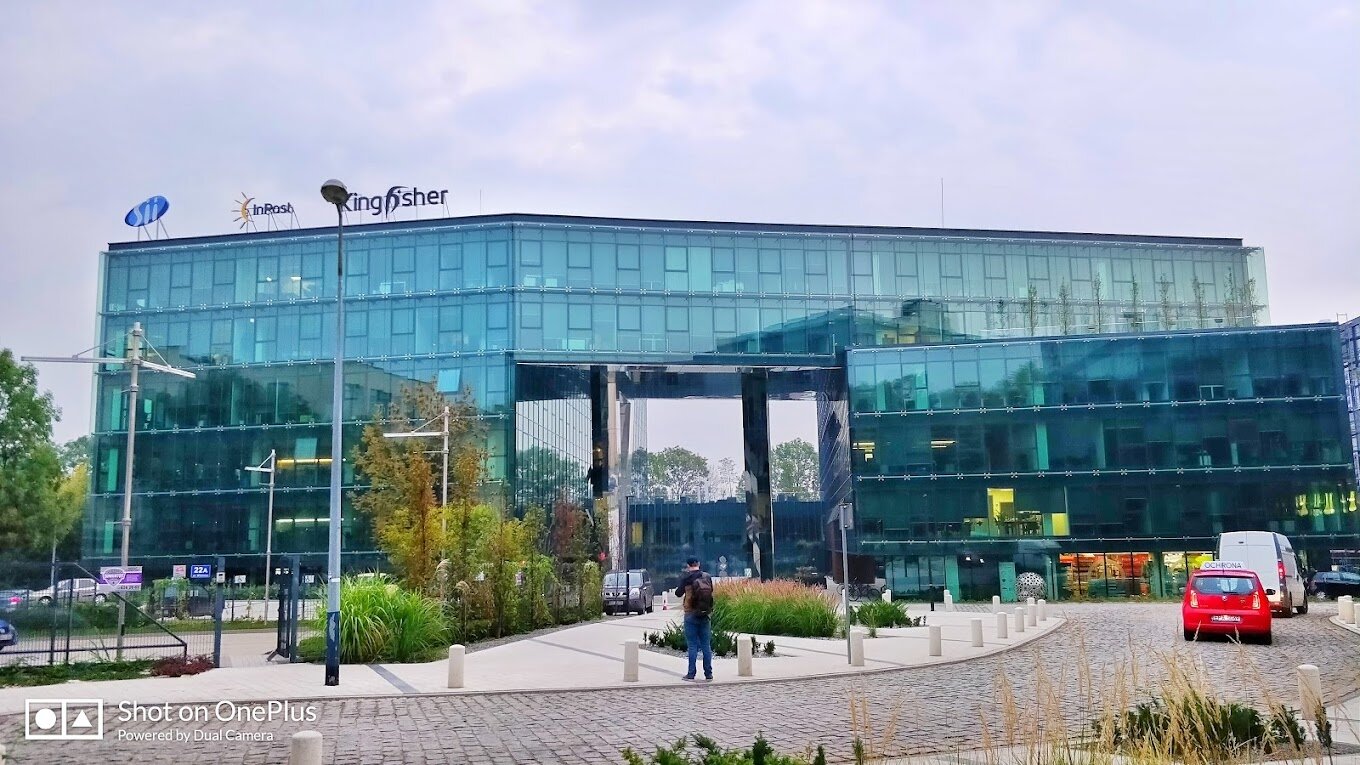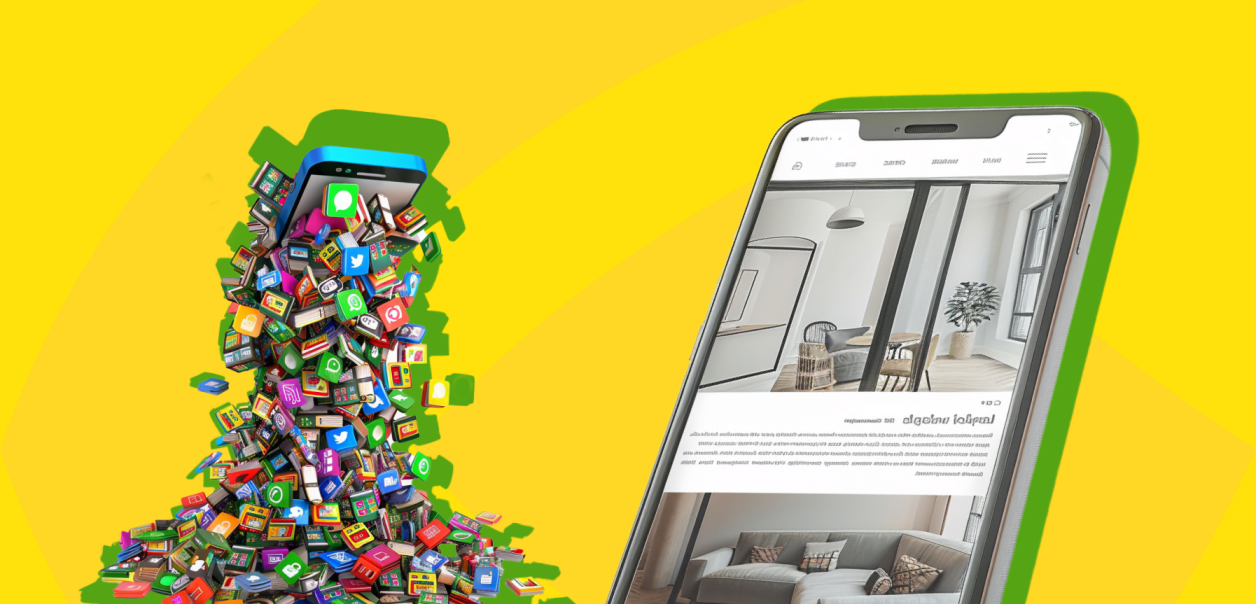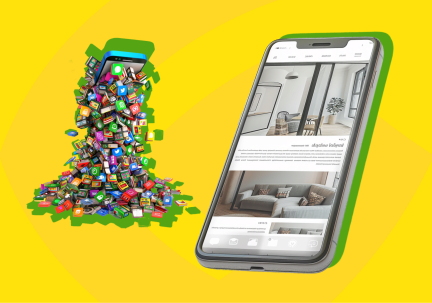Нові інструменти в сфері веб-дизайну

Існує думка, що інтернет в наш час майже повністю складається з растрової графіки. Виняток становить лише Флеш. Але сьогоднішній стан речей дає нам привід замислитися над тим, що, можливо, зовсім скоро, сфера веб-розробки буде піддана глобальним змінам. Давайте розглянемо, які існують можливості в веб-дизайні, щоб простежити тенденції, які готує нам майбутнє. Всі ми чули про те, що з метою розробки веб-сайтів можна використовувати векторну або растрову графіку.Растрова графіка на даний момент є найпоширенішою в інтернеті. З її допомогою можна відтворити будь-який малюнок або фотографію, точно передавши ефект переходу від одного кольору до іншого, що в векторній графіці призведе до втрат в розмірі файлу. Зображення в растрі зберігають високу реалістичність, до них можна застосовувати різноманітні ефекти.
Серед недоліків - занадто великий розмір файлів з простими зображеннями, при цьому не існує можливості ідеального масштабування. Растровий малюнок не отредактіруешь по верствам, як це можна було б зробити в векторній графіці. Набирає обертів зростання популярності векторної графіки. На відміну від растра, тут розмір не залежить від реальної величини об'єкта. Навіть дуже деталізовані векторні малюнки, що складаються з 1000 об'єктів, рідко перевищують кілька сотень кілобайт. Інформація про них зберігається в описовій формі, тому можна нескінченно збільшувати графічний примітив і змінювати параметри об'єктів. Це означає, що переміщення, масштабування, обертання, заповнення та виконання інших операцій не погіршить якості малюнка. Що стосується товщини ліній, то при збільшенні або зменшенні об'єктів, вона залишається стабільною, так як задана постійною величиною. Векторна графіка дає можливість редагувати малюнок по верствам, а також перекривати один об'єкт іншим, виключаючи будь-яке взаємодія. Але використання растрової графіки для створення зображень, які вимагають великої реалістичності, може виявитися неефективним. Векторні графічні редактори, дозволяють виконувати цілий ряд операцій. Серед них - обертання, переміщення, відображення, розтягування, скошування, зміна порядку шарів і створення більш складних об'єктів шляхом комбінування примітивів, а також об'єднання, доповнення, перетин замкнутих фігур. Векторна графіка ідеальна для простих або складених малюнків, які не потребують фотореалізм. Наприклад, модель векторної графіки використовують PostScript і PDF. Вектор і растр не існує відособлено один від одного. Їх можна комбінувати, отримуючи при цьому цікаві дизайнерські рішення.
А що ж було в минулому
Можливість впровадження в веб-розробку векторної графіки існувала і раніше. Створення векторної графіки для інтернету йде корінням в 1994-1995 роки. Саме тоді була розроблена і запропонована спочатку специфікація, а незабаром і плагіни до браузерів для SVF (Simple Vector Format), VRML (Virtual Reality Markup Language). 19 серпня 1998 року побачив світ альтернативу для CGM (Computer Graphic Metafile) - Web CGM. Ця розробка повинна була сприяти розширенню сфери застосування даного формату. З усіх представлених аналогів вижив тільки VRML. Його спочатку затвердили в рамках стандарту VRML97, а в 2004 році перетворили в X3D. У 1998 році Sun, IBM і Adobe, знайомлять нас з PGML, який повинен був використовуватися для представлення даних у векторному форматі в інтернеті. Приблизно в той же час Microsoft і кілька інших великих компаній представляють нашій увазі альтернативне рішення - стандарт VML. PGML (Precision Graphics Markup Language) -Мова розмітки, заснований на XML. З його допомогою векторну графіку на веб-сторінках можна описувати у вигляді тексту в форматі XML. PGML використовує схожу з PDF і PostScript модель побудови зображення. Після виходу в світ мову витіснили технології SVG і VML. На даний момент PGML майже не має сфери застосування, а серед підтримують формат програм тільки в ArgoUML можна виконувати експорт в PGML. VML (Vector Markup Language) описує зображення всередині сторінки HTML у вигляді тексту, по тим же синтаксичним правилам, що і HTML з CSS. Основою для VML також є XML, розроблений на базі HTML, що істотно розширює його можливості. У тому числі VML спирається і на інші, затверджені W3C відкриті стандарти, серед яких HTML 4.0, XML 1.0 і CSS 2. Google Maps використовує VML для візуалізації векторів на IE. Багато хто вважав, що ця технологія стане вікном в 3D Інтернет, однак незабаром VML поступився своїм місцем відкритим стандартам SVG. Зараз VML не можна назвати актуальною технологією. Формат підтримується тільки браузером Internet Explorer і Microsoft Office. Пару років тому Microsoft запропонувала плагін Silverlight для відтворення на веб-сторінці анімації і медійних додатків, і в тому числі відображення векторної графіки. Дана подія стала завершенням історії VML, також як і спрямованість розробників браузерів на підтримку SVG. Зараз Silverlight перебувати в стадії свого подальшого розвитку. Багато говориться про можливе світлому і не дуже майбутньому цієї розробки, але чим все закінчиться, ми дізнаємося, тільки через деякий час.
О флеше
При создании сайтов или отдельных их элементов часто используют Flash. Это мультимедийная платформа, которую применяют для разработки веб-приложений, мультимедийных презентаций. Flash также используют для создания рекламных баннеров, анимации, игр, а также воспроизведения на веб-страницах видео- и аудиозаписей. Для работы с Flash можно использовать векторную, растровую и ограниченно трёхмерную графику, формат осуществляет поддержку двунаправленной потоковой трансляции аудио и видео. Существует адаптированная под КПК и другие мобильные устройства «облегчённая» версия платформы Flash Lite. Функциональность разработки пришлось немного ограничить, чтобы она соответствовала возможностям мобильных устройств и их операционных систем. Основой Flash-анимации является векторный морфинг, когда один кадр плавно перетекает в другой. Так, с помощью лишь нескольких ключевых кадров, можно создавать сложные мультипликационные сцены. Если брать за критерий воспроизведение анимации, то по производительности Flash Player в несколько раз превосходит виртуальную машину Javascript в браузерах, где есть поддержка предварительного стандарта HTML5, хотя приложения, работающие вообще без использования виртуальных машин, находятся вне конкуренции. Языком программирования Flash является ActionScript, основанный на ECMAScript. У Flash есть несколько существенных недостатков, главный из которых состоит, пожалуй, в том, что центральный процессор подвергается чрезмерной нагрузке, которая связана с неэффективностью виртуальной машины Flash Player. Но в некоторых случаях flash-приложения просто недостаточно оптимизированы их разработчиками, часто также используются так называемые «генераторы» flash-приложений. Также из-за недостаточного контроля ошибок, происходят отказы, как самих приложений, так и всего браузера. Последнее неоднократно вызывало критику со стороны разработчиков браузеров. Иногда случаются трудности при запуске flash-приложений. Это может быть связано с тем, что в настройках браузеров отключается flash-контент для экономии системных ресурсов, избавления от надоевшей рекламы или в целях информационной безопасности (flash-приложения способны перехватывать содержимое буфера бмена). Этот недостаток ставит под сомнение универсальность технологии Flash, ограничивая её применение в критически важных веб-приложениях. Когда Flash используется для размещения текстовой информации, она не индексируется поисковыми системами. И хотя в 2008 году Google и Yahoo презентовали некоторую систему индексирования текста внутри swf-файлов, но до сих пор лишь небольшой процент разработчиков использует Flash для создания всего сайта. Также в Flash приложениях нельзя использовать правую кнопку мыши, так как ее зарезервировали сами разработчики браузеров для настроек Flash. И еще пару слов о безопасности. В реализациях Flash иногда находят «дыры», с помощью которых злоумышленники могут производить разнообразные действия с системой. Как, например, это и случилось в октябре 2008 года, когда обнаружили уязвимость, которая позволяла удалённо контролировать веб-камеру и микрофон. В браузерах отдельные части Flash могут быть заменены посредством HTML 5, JavaScript (и AJAX), SVG.
«Какие перспективы все же рисует будущее?» или «альтернатива Флешу»
Дуже ймовірно, що HTML5 зможе серйозно розширити наші уявлення про те, що може відбуватися в вікні браузера. Мова HTML5 - чергова глобальна переробка HTML, який дозволить докорінно вплинути на спосіб створення веб-сторінок, як розробниками, так і дизайнерами, а також змінити образ взаємодії їх з відвідувачами. HTML5 пропонує використовувати більш «чистий», простий і послідовний код, а також дозволяє позбутися від незручностей, пов'язаних з обмеженнями, які накладає використання сторонніх плагінів, в тому числі, Adobe Flash. Творцям HTML5 доведеться багато попрацювати, щоб їх специфікація стала надійною платформою для створення веб-сайтів. Крім того, що розробка повинна перевершувати свої аналоги по потужності і функціональності, вона також зобов'язана підтримувати вже існуючий вміст мережі, незважаючи на те, що там зараз цілковитий безлад. WebGL, мабуть, одне з найголовніших і цікавих нововведень. Ця технологія дозволяє браузеру відображати інтерактивні тривимірні сцени, прораховані на відеокарті. В недалекому майбутньому ця технологія буде доступна в будь-якому сучасному браузері без установки додаткових плагінів, а також підтримуватися пристроями на базі iOS і Android. Ми звикли, що розробники браузерів повністю вільні у способах обробки помилок. З приходом HTML5 ця тенденція змінитися. Тепер специфікація буде вказувати браузерам, як їм відображати відповідну стандартам верстку, а також визначати шляхи роботи з нею. Використовуючи «Canvas» в HTML5, користувачі зможуть обробляти графіку і зображеннях ще швидше і ефективніше, знову-таки, без необхідності застосування сторонніх плагінів. Забудьте про куках. Тепер для «Оффлайн» зберігання даних в браузері буде використовуватися веб-сховище. Багато хто погодиться, що куки давно застаріли т абсолютно не підходять для зберігання масивів даних на стороні веб-браузера. Технологія WebStorage позбавлена недоліків, якими володіють куки. HTML5 дає нам можливість використовувати два сховища виду «ключ-значення» на стороні веб-браузера з доступом з JavaScript, які підтримуються Firefox 3.5, Safari 4.0, IE8, Google Chrome, Opera 10.50 .:
- localStorage - для довготривалого зберігання даних;
- sessionStorage - для сесійної застосування.
Використовуйте потужний API, щоб швидко створювати малюнки на растрових 2D-поверхнях. Тут немає жодних файлових форматів, Ви можете малювати, використовуючи тільки скрипти, при цьому не застосовуються вузли DOM - все складається з пікселів. Ця характеристика дозволить більше сконцентруватися на малюванні, чи не переймаючись питаннями про складність зображення. Система междокументних повідомлень (Cross Domain Messaging) - це можливість обмінюватися даними документам, розміщеним на різних доменах безпечним способом. Функцію підтримують браузери Firefox і Google Chrome. Також одними з найважливіших характеристик HTML5 можна назвати
- «Drag-and-drop» -функціонал;
- Робота з мережею за допомогою веб-сокетів;
- Позиціонування (Geolocation);
- Нові типи полів форм.
За мовою розмітки HTML5 - майбутнє Інтернету. Поки він знаходиться в процесі розробки, але з кожним днем все більше його можливостей реалізуються в популярних веб-браузерах. Canvas - це елемент HTML 5 для створення растрових зображень за допомогою JavaScript. Історія Canvas сильно відрізняється від вищезазначених векторних стандартів. Початком всього стала запроваджена Apple ще в 2005 році техніка Canvas, створена для того, щоб попиксельно змінювати зображення всередині певної області полотна. Ідея підтримала Mozilla, яка інтегрувала її в Gecko 1.8 (Firefox 1.5 і вище), після чого вийшла дев'ята версія Opera з підтримкою Canvas. Потім Canvas, як частина стандарту Web Applications 1.0, увійшов в HTML5. Не дивлячись на те, що сьогодні сфера використання Canvas рідко виходить за рамки побудови графіків, простий анімації та ігор в веб-браузерах, WHATWG береться прогнозувати, що Canvas буде використовуватися в нових поколіннях веб-додатків як стандарт для створення графіки. Робота Mozilla Foundation над Canvas 3D проходить в напрямку додавання низкоуровневой підтримки графічних прискорювачів для відображення тривимірних зображень через HTML елемент Canvas. Сенс і головна фіча canvas-а складається в можливості динамічного оновлення його вмісту, отрісовивая нові елементи у відповідь на дії користувача. Здатність реагувати на події, які ініціюються відвідувачем сторінки, дозволяє створювати такі інструменти та іграх, які раніше вимагали б застосування сторонніх технологій, на зразок Флеша. Використання Canvas здатне робити роботу з Web-документами ще простіше. Безліч яскравих прикладів використання технології можна подивитися на www.canvasdemos.com. Хоча Canvas і з'явився відносно недавно, він вже встиг заручитися підтримкою більшості браузерів. Його можливості навіть реалізовані в IE, за допомогою додаткової Javascript-бібліотеки. Canvas в даний момент стрімко набирає популярність. Як тільки він стане більш «відкритим» для доступу ззовні, можна будете говорити про надійне закріплення його позицій. Цей елемент - не єдиний API для генерації динамічних зображень. Для опису тих самих фігур, що і Canvas, можна використовувати SVG. SVG (Scalable Vector Graphics) - це мова розмітки масштабована векторна графіки, розроблений Консорціумом Всесвітньої павутини (W3C). Він входить в підмножина розширюваної мови розмітки XML, і створений для опису двовимірної векторної і змішаної векторно / растрової графіки в форматі XML. SVG підтримує як анімовану і інтерактивну графіку, так і нерухому, іншими словами - декларативну і скриптовими. Основою відкритого стандарту SVG стали згадані вище мови розмітки VML і PGML. Можливості SVG досить широкі. Тут будь-яка фігура задається компактної рядком, яка описує шлях від початкової точки до кінцевої через будь-які проміжні координати. До фігурам і шляхах можна застосовувати забарвлення, обрізка кутів, прозорість та інші ефекти. Ще одна позитивна риса SVG - це інтерактивність. Вона дозволяє повісити обробник подій, як на кожен окремий елемент, так і на ціле зображення, щоб дозволити користувачеві управляти малюнком, переміщаючи мишкою деякі елементи або виконуючи інші дії. ECMAScript або JavaScript дозволять розробникам веб-графіки описувати сценарії будь-якого рівня складності, навіть якщо для цього знадобляться математичні обчислення координат і пропорцій фігур, що разом з SMIL анімацією і інтерактивністю дає дуже широкі можливості в сфері веб-розробки. Що пов'язано з текстовим форматом, то SVG файли піддаються читання і редагування в звичайних текстових редакторах. При перегляді документів, що містять SVG графіку, Ви маєте доступ до коду файлу, а також право збереження всього документа. SVG файли того ж якості, як правило мають менший розмір, ніж зображення в форматах JPEG або GIF, при цьому вони добре піддаються стисненню. Завдяки тому, що SVG - формат векторний, Ви можете збільшувати будь-яку частину зображення без втрати якості. Також до елементів SVG документа можна застосовувати фільтри для створення ефектів, таких як при роботі з растровими зображеннями - це розмиття, видавлювання, складні системи трансформації та ін. В тексті SVG-коду фільтри описуються тегами, візуалізувати які дозволяють кошти перегляду. Це не позначається на розмірі вихідного файлу, створюючи при цьому зображення з необхідною ілюстративної виразністю. У SVG документах є використання растрової графіки. Можна імпортувати елементи з зображеннями форматів PNG, GIF або JPG. На відміну від Flash, в графіку SVG текст можна виділяти і копіювати, він індексується пошуковими машинами, тому немає необхідності в створенні додаткових метафайлів для пошукових серверів. Динамічну і інтерактивну графіку в SVG можна створювати, використовуючи скрипти і анімацію. Формат забезпечує подієву модель, при якій відслідковуються такі події, як події миші, клавіатури, завантаження сторінки, зміна її параметрів, і ін. Що надає графіку інтерактивність, так це можливість запуску анімації по певній події (наприклад «onclick» або «onmouseover») , До подій кожного елемента можна прив'язувати окремі скрипти. SVG - відкритий стандарт і не є чиєюсь власністю. Документи SVG легко інтегруються з HTML і XHTML документами. Великий плюс розробки також складається в сумісності з CSS. SVG залишає за собою всі переваги XML:
- Возможность работы в различных средах.
- Интернационализация (поддержка Юникода).
- Широкая доступность для различных приложений.
- Простая модификация через стандартные API.
- Несложное преобразование таблицами стилей XSLT.
- Крім переваг, SVG також успадковує деякі недоліки XML. Це великий розмір файлу, який можна компенсувати існуванням стисненого формату SVGZ і великою швидкістю інтернету. Також SVG не ефективний для роботи з великими картографічними додатками, так як для правильного відображення невеликої частини зображення необхідно прочитати повністю весь документ. Щоб зменшити розмір коду SVG, була розроблена «обгортка» SVGZ. Файл SVG стискають за допомогою gzip, і виходить файл з розширенням «SVGZ». Ця операція відбувається досить просто і результативно, так як це текстовий XML-документ з регулярною структурою. На сьогоднішній день не існує ідеальної середовища роботи з форматом, але цілком реально скористатися наявними можливостями, які пропонують такі програми:
- Inkscape - вільний векторний графічний пакет для роботи з SVG.
- OpenOffice.org Draw вміє експортувати графіку в файли формату SVG.
- sK1 - вільний векторний графічний редактор.
- MetaPost - мова програмування, що використовується для створення графічних ілюстрацій.
- Adobe Illustrator версії від 10.0.
- Adobe GoLive версії від CS2.
- CorelDRAW векторний графічний редактор.
- Visio векторний графічний редактор від Microsoft.
- librsvg - бібліотека, яка використовується в Mediawiki для роботи з SVG.Batik - Java бібліотека для генерації, відтворення і різних маніпуляцій зображеннями в SVG форматі і заснований на цій бібліотеці SVG-браузер - Squiggle.
Звичайні графічні редактори в кращому випадку пропонують при відкритті векторного файлу задати розмір зображення (як у випадку з Adobe Photoshop при відкритті EPS-файлів) і растрируется картинку, а частіше за все не розуміють векторні зображення взагалі або підтримують тільки один формат вектора - WMF. Більш того, іноді графічні файли, збережені в новій версії програми, можуть не підтримуватися старої, як у випадку з Corel Draw. Зараз SVG вже підтримується багатьма сучасними браузерами, виняток становить IE, для якого потрібна емуляція всіх методів через VML
Як у можливому майбутньому буде виглядати веб-сайт
Перераховані вище технології дозволяють веб-розробникам задуматися про можливості реалізації повністю векторного або векторного з впровадженням растрового зображення в тіло SVG веб-сайту, Зображення, які є результатом перекладу з вектора в растр, майже завжди унікальні. Це дозволяє їм бути гідно оціненими пошуковими системами при ранжуванні картинок. Також варто врахувати той факт, що в векторній графіці немає місця проблемам з фонами, формами і текстурами. Хіба це не досить вагома причина того, що саме Кліпарт векторний малюнків повинен віддавати перевагу веб-дизайнер? На даний момент не існує повністю спеціалізованої середовища розробки для даних сайтів. Але є програми, які вже сьогодні застосовуються для роботи з векторною графікою. Це Adobe Illustrator, CorelDraw, Inkscape, Macromedia FreeHand, а також деякі інші, які вже згадувалися в цій статті. Інтернет вже переповнений чутками про нові можливості, які пропонує розробникам HTML5 і що завдяки цьому, Flash може остаточно втратити свої позиції. А тим часом компанія Google випустила онлайн книгу «20 Things I Learned About Browsers & The Web». Книга дозволяє кожному перегортати сторінки і залишати закладки. Для її створення використовувалася технологія HTML5. Завдяки цьому кожна сторінка книги це html сторінка, і текст книги легко індексується пошуковими системами. http://www.20thingsilearned.com/home Крім різних демо-версій і он-лайн експериментів, існує певна кількість робочих сайтів, написаних на HTML5. Один з них www.elladesign.com. Це дійсно гарний сайт з сучасним дизайном. Тепла пастельна колірна гамма, привабливий кліпарт і продумана інтерактивність змушують кожного гостя відчувати тут себе як вдома. Візуальні ефекти, які ми зустріли на сайті www.jayarajpr.com, мають усі переваги Flash-анімації, але позбавлені її недоліків. Сайт дуже стильний і інформативний. Вельми привабливе колірне рішення. Дизайн сайту www.pixelbender.ca відмінно передає його суть. Недбалість і гранж доповнюють відчуття затишку. Інтернет-ресурс eyestylesllc.com радує око гарною витриманою палітрою. Не можна не відзначити відмінно продумане юзабіліті, реалізоване за допомогою HTML5.www.kingscooty.com — еще один сайт, который мы предлагаем Вашему вниманию. Первые характеристики, которые приходят на ум, когда попадаешь на этот ресурс это — контраст, четкость и информативность.Висновки
Використання HTML5, SVG і Canvas в найближчому майбутньому може носити глобальний характер і, прямуючи з вищевикладеного, в цьому немає нічого дивного. Можливості, які пропонують нам HTML5 в зв'язці з мовою програмування Java Script і іншими сучасними інструментами мало чим поступаються Flash технологій, більш того, перед розробниками з'являються нові можливості, про які вони раніше могли і не мріяти. Більшість новинок, про які ми говорили, успішно впроваджуються в сферу веб-розробки, а браузери вибирають спрямованість на їх підтримку. Як говорить глава маркетингового відділу W3C Ian Jacobs: «Розробники можуть використовувати HTML5 вже сьогодні, і ми закликаємо їх робити це». Тому майбутнє Флеша в якості інструменту для інтернет-анімації виглядає дещо туманним. Можна припустити, що ці технологічні нововведення стануть початком переходу на новий рівень розвитку можливостей веб-розробки.
- Крім переваг, SVG також успадковує деякі недоліки XML. Це великий розмір файлу, який можна компенсувати існуванням стисненого формату SVGZ і великою швидкістю інтернету. Також SVG не ефективний для роботи з великими картографічними додатками, так як для правильного відображення невеликої частини зображення необхідно прочитати повністю весь документ. Щоб зменшити розмір коду SVG, була розроблена «обгортка» SVGZ. Файл SVG стискають за допомогою gzip, і виходить файл з розширенням «SVGZ». Ця операція відбувається досить просто і результативно, так як це текстовий XML-документ з регулярною структурою. На сьогоднішній день не існує ідеальної середовища роботи з форматом, але цілком реально скористатися наявними можливостями, які пропонують такі програми:
Website development for the Polish market!

We are your reliable partner in setting up and developing your business in Poland. Our company offers a full range of services for the launch and successful operation of your company in this country. We specialize in the development of websites in Polish, adapted to the needs of the local audience. Our web development professionals have many years of experience in designing and optimizing websites for the Polish market, which will allow your business to compete effectively and attract customers.
Our services include:
- Polish website development: Our website development professionals will create an effective and attractive Polish-language website for you that will attract the attention of local customers.
- Marketing services in Poland: We will develop a marketing strategy for you that will allow you to set up effective advertising campaigns and attract your target audience.
- Rebranding your business: Our rebranding experts will help you update your company's image and emphasize your strengths to attract new customers.
Cooperation with us covers a wide range of services for entrepreneurs and companies expanding their activities in the international market. We offer professional translation of documents and information, advice on local banks and financial procedures, assistance in registering a business and opening a branch, as well as support in choosing a payment and delivery system. In addition, we can provide you with contacts for registering a legal entity in Poland, office selection, accountant contacts and other services. We make sure that your business initiatives are successfully implemented in the new market conditions.

Address of the office in Poland: Biuro 315, Regus Equal Park 3rd Floor, Wielicka 28, 30-552 Kraków
Don't waste time - choose our company for a successful start in Poland. We know how to make your business competitive in this market!
For a successful start in Poland, please contact us:
📞 Phone: 0 (800) 750-751
📧 E-mail: [email protected]
How a website audit can transform your business

A website audit is not a simple check, it is a necessity that allows you to deeply understand both the technical and marketing aspects of your site. Is your website optimized for search engines? Does it communicate effectively with your potential customers? The answers to these questions can radically change your approaches and strategies. Ordering a website analysis can reveal hidden issues that are holding back your site's lead generation and customer acquisition potential. Whether you're looking to improve your site's search engine rankings or increase user satisfaction, an audit can provide you with the tools and guidance you need.
We will look at how a carefully prepared audit can significantly improve your website and make it more competitive. We will discuss what aspects of a website are checked during an audit, what benefits it can bring to your business, and how you can order a website audit from professionals to ensure the best results.
Why does your business need a website audit?
Excellent website usability is not just a nice bonus, but a critical condition for ensuring online success. A website audit allows you to analyze in detail how conveniently and efficiently users interact with your site, and how this affects your business's ability to achieve its goals. Here are some reasons why it is important:
- Increase user satisfaction: An audit reveals navigation and interface issues that may prevent users from easily and intuitively finding the information they need or performing the actions they want on your site. Improving these aspects can significantly increase your visitors' satisfaction.
- Reduce bounce rate: When users find it difficult to navigate the site or perform the necessary actions, they are more likely to leave the site without converting. An audit helps to identify and fix design elements that can lead to a high bounce rate.
- Increase conversions: Website optimization can have a direct impact on your conversions. For example, simplifying the checkout process or improving the visibility of a call-to-action button can significantly increase the number of successful transactions.
- Search engine optimization: SEO audit and optimization is part of the overall website audit and focuses on aspects that affect your website's visibility in search engines. Analyzing keywords, meta tags, URL structure, and other SEO practices will help to push your website higher in search results.
- Improving accessibility: The audit also assesses how accessible your site is to people with disabilities. Ensuring accessibility not only expands your target audience, but also emphasizes your responsibility as a business.
- Optimization for mobile devices: Nowadays, it's important that your website is optimized for mobile users. An audit will help ensure that your website works efficiently on all types of devices, improving the overall user experience.
Ensuring a high quality website is an investment in customer satisfaction and the efficiency of your online space. Ordering a professional audit can help you identify critical issues and resolve them before they negatively affect your business. You can read more about SEO promotion in the article "Features of SEO optimization of an online store"
How the audit is conducted and what we offer
Website audit is a complex process that includes several key stages. Each stage has its own specifics and requires a detailed approach. Our team of specialists uses advanced technologies and techniques to ensure the highest quality of services. This is how we work:
- Audit planning: First of all, we identify your business goals and website features. This helps us to prepare a personalized audit plan that takes into account all the necessary aspects: from technical analysis to user experience assessment.
- Technical audit: At this stage, we check the technical component of the website: coding, information architecture, compliance with SEO and web accessibility standards. We identify technical errors that may prevent the site from being indexed by search engines or impair overall performance.
- User experience (UX) audit: We analyze how visitors interact with your website and evaluate the usability of the interface. In this context, we can also put a heatmap on the site. Heatmaps allow you to visualize where users click most often, how long they stay on certain segments of the page, and how they scroll through the page. This is very useful for improving page structure and content.
- Report and recommendations: At the final stage, we compile a detailed report that includes all the issues we found and specific recommendations for fixing them. We provide practical advice that can be implemented quickly to improve your website.
- Support and optimization: After the audit, we also offer website maintenance and optimization services. This can include regular updates, monitoring of website performance, and additional checks for compliance with changed requirements or technologies.
Our goal is not just to identify problems, but to provide you with the tools and knowledge to solve them effectively, so that your website not only works at full capacity, but also helps you grow your business.
Glyanec provides professional website audit services that include technical audit, usability testing, SEO optimization, and analysis of your website's accessibility and security. We use advanced tools, such as heatmaps, to analyze user behavior in depth, allowing us to offer targeted and effective solutions for each client.
If you want to ensure that your website functions at the highest level, meets all modern requirements, and works as a powerful tool for your business, contact us. Order a website audit in Glyanec today and take the first step towards improving your online space. We guarantee a professional approach and dedication to achieving your business goals.
What are the advantages of websites over mobile apps?

Different companies are faced with the choice between developing mobile apps and websites every day. While mobile apps may seem convenient and innovative, it's important not to ignore the numerous advantages of websites. Ordering a website is not just an investment in an online presence, but a strategic decision that can significantly reduce development and maintenance costs, provide a wider audience reach, and improve search engine rankings.
We'll take a closer look at why websites compare favorably to mobile apps, analyzing their functionality, accessibility, and maintenance costs. The importance of websites in today's digitalized landscape cannot be underestimated, as they play a key role in attracting customers, expanding the market, and optimizing the user experience.
What is a website and a mobile application?
Websites and mobile apps play vital roles in promoting a business, but they have significant differences. A mobile app is a program downloaded and installed on a mobile device that can use the phone's system capabilities, such as a camera, GPS, or gyroscope. They can offer a more personalized experience, but they require significant investment to develop and maintain.
Therefore, choosing between website development and in-house development usually turns out to be a more profitable and effective solution.
Main advantages of websites
Websites offer a number of benefits that make them an attractive choice for businesses of all sizes. Let's take a look at a few of the key benefits you should consider when considering a website for your business.
- Universal access: One of the main advantages of websites is their accessibility. Visitors can access your site from any device that has an Internet connection, regardless of the operating system. This provides a wide audience reach and the ability to attract more potential customers.
- Cost-effectiveness: Ordering a website is often much cheaper than developing a mobile app. The cost of developing and maintaining a website is lower because you don't need to create separate versions for different platforms, such as iOS and Android. In addition, updates and changes to the site can be implemented faster and easier, which reduces overall maintenance costs.
- SEO and marketing benefits: Websites provide better opportunities for search engine optimization (SEO). This means that your website can rank higher in search engines, increasing the chances of being discovered by potential customers. Optimizing your website for search engines helps to increase its visibility and attract more organic traffic.
- Improving the user experience: Websites can offer a rich and user-friendly user interface that is adapted for different devices, including mobile phones, tablets, and desktops. With a responsive design, users can easily navigate the site, which improves the overall user experience and can increase conversion rates.
With these benefits in mind, building a website is a rational choice for businesses looking to maximize the benefits of their online presence. Not only do websites save money and resources, but they also provide ample opportunities to scale and grow your business.
Why do users abandon mobile apps?
Despite the significant development of mobile technology and the increase in the number of available apps, many users still prefer websites. This is due to a number of reasons that point to certain disadvantages of mobile apps and limitations that can affect the user experience.
Most users do not see the need to install mobile applications when they can easily access the same services or information through a website on their laptop or smartphone via a browser. This is especially true for those services that users use infrequently or sporadically.
Additionally, users emphasize that mobile apps often take up too much space on their devices, which can be critical for those with limited storage space. There are also concerns about battery and mobile data consumption, especially when apps are running in the background or transferring large amounts of data.
Privacy and security issues
One of the biggest concerns that pushes users away from mobile apps is the issue of privacy and security. Many apps require extensive permissions to access personal information such as contacts, location, social media data, and even personal files, which raises concerns among users about how this data is collected, stored, and used. There is also a fear that mobile apps may be vulnerable to hacking, especially those that store sensitive financial data or personal information. Data breaches at large companies that have made headlines only reinforce these concerns.
These factors contribute to the fact that many users prefer to use websites that do not require a download and provide quick access to services without the need to install resource-consuming applications. This confirms that websites can be a more convenient and secure solution for many users. However, for many companies, creating a website will prove to be the most optimal solution to effectively attract customers and provide high quality service with minimal costs and complexity.
To summarize, a careful choice between website and mobile app development should be based on the specific needs of the business, its target audience, and available resources. However, for many companies, ordering a website will prove to be the most optimal solution that allows them to effectively attract customers and provide high quality service with minimal costs and complexity.
What are progressive web applications and what are their advantages

Progressive Web Applications (PWAs) are changing the way we think about what websites can do. This technology combines the best of the web and mobile applications, offering speed and usability that was previously only possible in apps. In this article, we'll take a closer look at what progressive web apps are, what technologies are behind them, their benefits, and key implementation considerations. We will pay special attention to how progressive web applications can transform your business by providing a better user experience and increasing productivity.
What are progressive web applications?
Progressive web applications are a type of software that is split into a website and a mobile application. This allows users to install web applications on their devices and use them in a similar way to regular mobile applications. An important feature of PWAs is that they use web browser technologies but offer functionality that is usually associated only with mobile applications.
The PWA concept was first introduced by Google in 2015. The goal was to make the web experience as convenient and fast as possible. Since then, the technology has gained significant development and support, especially from companies seeking to improve the mobile user experience without losing the versatility and accessibility of the web.
Technologies used in advanced web applications
Progressive web applications use a number of modern web technologies to provide users with an experience that is as close as possible to mobile applications. The most important of these technologies are:
- Service Workers - scripts that run in the background, independently of the web page, and allow you to manage network requests, cache resources, and use push notifications.
- Manifest file - a JSON file that allows developers to install a web application on the home screen, set the icon and the start screen.
- Using HTTPS - ensuring the security of user data and the reliable operation of web applications.
Why progressive web applications are better than traditional sites
Improving the user experience
Progressive web applications are characterized by extremely fast loading speeds and high responsiveness, which is ensured by data caching and intelligent management of network requests. This means that users are able to access content instantly, regardless of the quality of their Internet connection, which significantly improves the overall user experience.
Offline access and support for push notifications
One of the defining features of PWA is the ability to work offline. This is achieved thanks to Service Workers technology, which allows web applications to cache important content and provide access to it without the need for an Internet connection. In addition, PWAs can use push notifications to inform users about news, updates, or special offers even when they are not using the web application.
Increase engagement and conversion rates
Thanks to better user experience and offline capabilities, PWAs demonstrate high rates of user engagement and increased conversions. The ability to load quickly and run smoothly on any device ensures higher customer loyalty and a higher likelihood of completing targeted actions, such as making a purchase or filling out a contact form.
Steps to implement progressive web applications in your business
Implementing progressive web applications may seem daunting, but with the right approach, the process can be efficient and smooth. Here are the basic steps to integrate PWA into your business:
- Audit the current state of the website - check if your site is ready for conversion to PWA. This includes ensuring HTTPS compatibility, site responsiveness on different devices, and the availability of all necessary technical aspects.
- Developing and configuring Service Workers is a key component of PWA that allows the website to work offline and use push notifications.
- Creating a web app manifest - a manifest allows users to add your app to the home screen of their devices, providing easier access and a more native experience.
- PWA testing - ensure that your PWA works properly across all devices and browsers, with special attention to offline mode and loading speed.
- Monitoring and updating - once your PWA is up and running, it's important to keep it up to date and make updates to resolve any issues or improve functionality.
To illustrate how easily and quickly users can install a progressive web application on their devices, we have prepared an animated GIF. This GIF shows the process from the moment a user visits a website to the moment they install the web application on the home screen of their mobile device. This demonstrates the simplicity and ease of use of PWAs, as well as their ability to offer a native experience through a web browser.

Progressive web apps are a powerful tool for business development, offering speed, convenience, and an enhanced user experience comparable to native mobile apps. They allow you to achieve a high level of customer engagement, provide the ability to work offline and send push notifications, which is critical in today's dynamic market. Thanks to their ease of installation and efficiency, PWAs can significantly increase conversion rates and improve the overall user experience.
If you're looking for a way to make your web experience more efficient and engaging, progressive web applications can be a great solution. Remember that proper implementation and ongoing updates are essential to the success of any technology solution. Don't hesitate to bring in professionals to help you optimize your website to turn it into a responsive web app and take full advantage of its capabilities.
Virtual fitting rooms in online stores: how artificial intelligence is changing shopping

In a world where technology is changing every aspect of our lives, online shopping has become one of the fastest growing areas. However, despite all the convenience that shopping from home offers, there is one problem that still makes many shoppers hesitate before clicking the "buy" button: the inability to try on clothes before buying. This is where innovative technologies, such as virtual fitting rooms, come into play, promising to revolutionize the way we buy clothes online.
Virtual fitting room is a cutting-edge technology that uses artificial intelligence and machine learning to allow customers to try on clothes virtually before making a purchase. This innovation has the potential not only to provide a better online shopping experience, but also to fundamentally change the entire retail sector.
Our company is closely monitoring this area of technology and expects its rapid development in the near future. We believe that the integration of such innovations will not only increase customer satisfaction, but will also significantly improve the efficiency of online stores by reducing the number of returns due to mismatched sizes or appearance of goods.
Evolution of virtual fitting rooms
From early experiments to today's advanced systems, virtual fitting rooms have come a long way. Initial attempts to implement digital solutions for trying on clothes were criticized due to poor visualization quality and limited functionality. However, with the advent of advanced artificial intelligence technologies and improved image processing algorithms, virtual fitting rooms are becoming much more accurate and useful for the end user.
The key to the success of virtual fitting rooms lies in the use of a range of technologies. This includes computer vision, artificial intelligence, machine learning, and image processing algorithms. These technologies allow to analyze users' photos in real time, adapting clothes to their body parameters. In addition, advanced interfaces ensure that these systems are intuitive and easy to use.
Benefits for consumers and businesses
Virtual fitting rooms offer significant benefits for both customers and store owners. For consumers, it is an opportunity to visually assess how the clothes will fit them without having to visit a physical store or wait for the goods to be delivered. This significantly increases customer satisfaction and reduces the number of returns. On the other hand, retailers are able to attract more customers by offering a unique shopping experience and reduce the costs associated with handling returns. As a result, virtual fitting rooms not only boost sales but also improve business sustainability.
Online fitting - how does it work?
Integrating a virtual fitting room into a website requires a comprehensive approach that includes the development or implementation of specialized software. This software uses artificial intelligence algorithms to analyze user-entered data, such as body measurements, or even real-time photos or videos to create an accurate virtual image on which to "try on" clothes.
Artificial intelligence plays a key role in the functioning of virtual fitting rooms, as it analyzes and processes user data to create an accurate three-dimensional model. Such systems can recommend the most suitable size of clothing, taking into account not only the size but also the personal preferences of users regarding the fit of clothing. The introduction of virtual fitting rooms is changing not only the way people buy clothes, but also the overall online shopping experience. Customers are able not only to visually see how the clothes will look on them, but also to experiment with different styles and colors without the need to physically visit the store. This interactive approach can greatly enhance the user experience, increasing shopping satisfaction while reducing the likelihood of returning an item due to a failure to meet expectations.
Advantages of online clothing fitting
The use of online clothing fitting technologies brings significant benefits that affect both the consumer experience and the efficiency and sustainability of retail business models. Let's look at the key aspects of these benefits:
Reducing the number of product returns
One of the biggest challenges for online retailers is the high number of returns, which is often due to mismatches in sizing or customer expectations of how the product looks. Online clothing fitting can significantly reduce this risk by giving customers a better understanding of how the clothes will fit them, which in turn leads to more confident purchases and fewer returns.
Increasing customer satisfaction and loyalty
Enhancing the online shopping experience through a virtual fitting room helps to increase overall customer satisfaction. Interactivity and personalization of purchases strengthen the relationship between brands and their customers, encouraging repeat purchases and increasing loyalty.
Impact on environmental friendliness and business sustainability
Reducing the number of returns not only improves economic efficiency for businesses, but also has a positive impact on the environment. Reducing the need to transport returned goods helps to reduce the carbon footprint of companies, making them more sustainable and environmentally responsible.
The future of the fitting room for an online store
One of the main trends is to improve the accuracy and interactivity of virtual fitting rooms through the expanded use of artificial intelligence and machine learning. This includes the development of algorithms that can analyze the more subtle nuances of users' figures, as well as integration with virtual and augmented reality to create a more immersive fitting experience.
Artificial intelligence not only improves virtual fitting rooms, but also opens up new opportunities for personalizing fashion offers. This can include automatic clothing recommendations based on previous purchases, lifestyle, and personal preferences, which will significantly improve the user experience and shopping efficiency.
By closely following these trends and actively experimenting with virtual fitting rooms, our company strives not only to optimize our customers' experience, but also to act as an integration leader in the market. Recognizing the importance of these innovations, we are confident that the further introduction and development of virtual fitting rooms will not only contribute to the growth of our company, but will also play an important role in shaping the future of online retail by making shopping more convenient, personalized and sustainable.
Just one step to your perfect website




